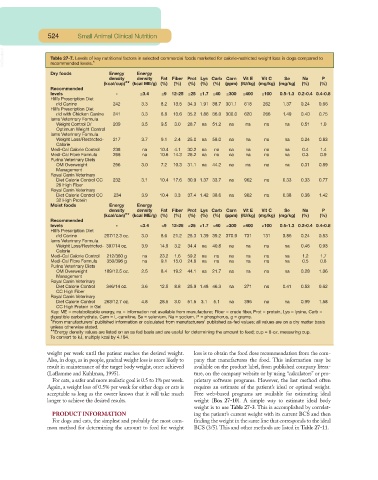Page 508 - Small Animal Clinical Nutrition 5th Edition
P. 508
524 Small Animal Clinical Nutrition
VetBooks.ir Table 27-7. Levels of key nutritional factors in selected commercial foods marketed for calorie-restricted weight loss in dogs compared to
recommended levels.*
Dry foods Energy Energy
density density Fat Fiber Prot Lys Carb Carn Vit E Vit C Se Na P
(kcal/cup)** (kcal ME/g) (%) (%) (%) (%) (%) (ppm) (IU/kg) (mg/kg) (mg/kg) (%) (%)
Recommended
levels - ≤3.4 ≤9 12-25 ≥25 ≥1.7 ≤40 ≥300 ≥400 ≥100 0.5-1.3 0.2-0.4 0.4-0.8
Hill’s Prescription Diet
r/d Canine 242 3.3 8.2 13.5 34.3 1.91 38.7 301.1 618 262 1.37 0.24 0.66
Hill’s Prescription Diet
r/d with Chicken Canine 241 3.3 8.8 13.6 35.2 1.86 36.0 300.0 620 266 1.49 0.40 0.75
Iams Veterinary Formula
Weight Control D/ 209 3.5 9.5 3.0 28.7 na 51.2 na na na na 0.51 1.0
Optimum Weight Control
Iams Veterinary Formula
Weight Loss/Restricted- 217 3.7 9.1 2.4 25.0 na 58.0 na na na na 0.24 0.83
Calorie
Medi-Cal Calorie Control 238 na 10.4 4.1 30.2 na na na na na na 0.4 1.4
Medi-Cal Fibre Formula 266 na 10.6 14.3 26.2 na na na na na na 0.3 0.9
Purina Veterinary Diets
OM Overweight 266 3.0 7.2 10.3 31.1 na 44.2 na na na na 0.31 0.89
Management
Royal Canin Veterinary
Diet Calorie Control CC 232 3.1 10.4 17.6 30.9 1.37 33.7 na 962 na 0.33 0.33 0.77
26 High Fiber
Royal Canin Veterinary
Diet Calorie Control CC 234 3.9 10.4 3.3 37.4 1.42 38.6 na 962 na 0.38 0.38 1.42
32 High Protein
Moist foods Energy Energy
density density Fat Fiber Prot Lys Carb Carn Vit E Vit C Se Na P
(kcal/can)** (kcal ME/g) (%) (%) (%) (%) (%) (ppm) (IU/kg) (mg/kg) (mg/kg) (%) (%)
Recommended
levels - ≤3.4 ≤9 12-25 ≥25 ≥1.7 ≤40 ≥300 ≥400 ≥100 0.5-1.3 0.2-0.4 0.4-0.8
Hill’s Prescription Diet
r/d Canine 257/12.3 oz. 3.0 8.6 21.2 25.3 1.39 39.2 370.9 731 131 0.86 0.24 0.53
Iams Veterinary Formula
Weight Loss/Restricted- 397/14 oz. 3.9 14.9 3.2 34.4 na 40.8 na na na na 0.46 0.93
Calorie
Medi-Cal Calorie Control 212/360 g na 23.2 1.6 59.2 na na na na na na 1.2 1.7
Medi-Cal Fibre Formula 350/396 g na 9.1 15.0 24.8 na na na na na na 0.5 0.8
Purina Veterinary Diets
OM Overweight 189/12.5 oz. 2.5 8.4 19.2 44.1 na 21.7 na na na na 0.28 1.06
Management
Royal Canin Veterinary
Diet Calorie Control 346/14 oz. 3.6 12.5 8.8 25.9 1.48 46.3 na 271 na 0.41 0.53 0.62
CC High Fiber
Royal Canin Veterinary
Diet Calorie Control 263/12.7 oz. 4.8 28.5 3.0 51.5 3.1 5.1 na 396 na na 0.99 1.58
CC High Protein in Gel
Key: ME = metabolizable energy, na = information not available from manufacturer, Fiber = crude fiber, Prot = protein, Lys = lysine, Carb =
digestible carbohydrate, Carn = L-carnitine, Se = selenium, Na = sodium, P = phosphorus, g = grams.
*From manufacturers’ published information or calculated from manufacturers’ published as-fed values; all values are on a dry matter basis
unless otherwise stated.
**Energy density values are listed on an as fed basis and are useful for determining the amount to feed; cup = 8-oz. measuring cup.
To convert to kJ, multiply kcal by 4.184.
weight per week until the patient reaches the desired weight. loss is to obtain the food dose recommendation from the com-
Also, in dogs, as in people, gradual weight loss is more likely to pany that manufactures the food. This information may be
result in maintenance of the target body weight, once achieved available on the product label, from published company litera-
(Laflamme and Kuhlman, 1995). ture, on the company website or by using “calculators” or pro-
For cats, a safer and more realistic goal is 0.5 to 1% per week. prietary software programs. However, the last method often
Again, a weight loss of 0.5% per week for either dogs or cats is requires an estimate of the patient’s ideal or optimal weight.
acceptable as long as the owner knows that it will take much Free web-based programs are available for estimating ideal
longer to achieve the desired results. weight (Box 27-10). A simple way to estimate ideal body
weight is to use Table 27-3. This is accomplished by correlat-
PRODUCT INFORMATION ing the patient’s current weight with its current BCS and then
For dogs and cats, the simplest and probably the most com- finding the weight in the same line that corresponds to the ideal
mon method for determining the amount to feed for weight BCS (3/5). This and other methods are listed in Table 27-11.

